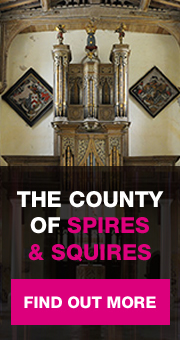Northampton’s Guildhall speaks volumes of the thriving economy and cultural aspirations of the town in the mid 19th century. The building is triumphal and richly decorated, in the Gothic idiom. The architect was one of Britain’s most innovative designers of the second half of the century, who won the competition aged only 28. Edward Godwin was strongly influenced by John Ruskin’s book The Stones of Venice which accounts for the continental style of the building and its varied use of different coloured stones. The muscular strength of the architecture and the strongly worked interior decoration shows another influence, that of William Burges under whom Godwin trained. The result is an exuberant Gothic structure, richly polychromatic centred on a tower (the left-hand side is extended in a similar style by the local architect Matthew Holding in the early 1890’s). The choice of style may reflect the fact that Northampton had previously had two great Guildhalls, first in the 12th century, to be replaced by another in the 14th century, when the town was a Royal administrative centre.
Internally the rooms are as impressive, an imaginative realisation of medieval interiors both in its architecture and decoration, sculptural and painted. The building though was thoroughly modern in its construction in its use of cast iron etc. The Great Hall is particularly impressive but so too is the Council Chamber (now known as the Godwin Room) with its original neo - Norman furniture. To the right of the building is a highly successful extension by Simpston and Walton, 1991. Here you will find in the courtyard Sir Francis Chantrey’s statue of the local MP, The Prime Minister Spencer Perceval (1762 – 1812).







